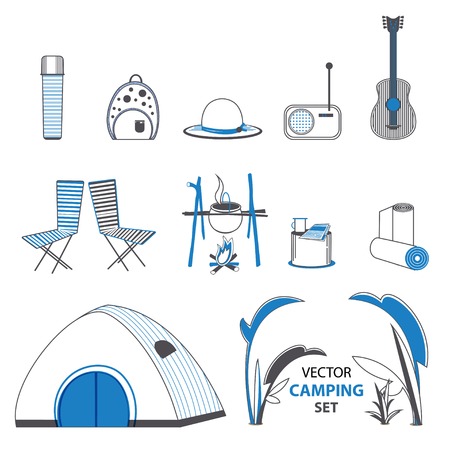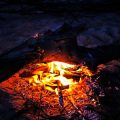Understanding Your Camping Needs
Before you start browsing for campsites, it’s important to figure out what kind of camping experience youre aiming for. Whether youre dreaming of a peaceful tent setup under the stars or a cozy RV spot with full hookups, your comfort level will play a big role in choosing the right location.
Know Your Camping Style
Campsites in the U.S. range from primitive backcountry spots to fully equipped campgrounds with Wi-Fi and hot showers. Think about what youre comfortable with and what amenities are must-haves for you.
Common Camping Styles and What They Offer
| Camping Style | Description | Common Amenities |
|---|---|---|
| Rustic Tent Camping | Basic sites with minimal facilities, often in remote areas | Fire ring, pit toilet, no electricity |
| Developed Campgrounds | Designated campsites in national/state parks or private land | Restrooms, potable water, picnic tables, trash bins |
| Car Camping | Drive-up sites where you set up camp next to your vehicle | Parking pad, fire ring, access to restrooms and water |
| RV Camping | Sites designed for motorhomes or trailers | Electric/water/sewer hookups, dump stations, sometimes Wi-Fi and cable TV |
| Glamping (Glamorous Camping) | Luxury-style camping with pre-set tents or cabins | Beds, electricity, private bathrooms, A/C or heating |
Questions to Ask Yourself Before Choosing a Campsite
- Do I want a primitive nature escape or modern comforts?
- Am I bringing kids or pets who might need extra amenities?
- Do I need accessibility features like paved paths or ADA-compliant restrooms?
- How far am I willing to travel from home?
- Will I be cooking over a fire or using electric appliances?
The answers to these questions will help you focus on campsites that match your needs. For example, if you’re new to camping and prefer not to rough it too much, looking for developed campgrounds with clean bathrooms and potable water might be your best bet. On the other hand, if youre ready to embrace nature fully, a remote tent site may offer the peace and quiet youre after.
2. Essential Amenities to Look For
When youre heading out on your first camping trip, comfort and convenience can make a big difference in how much you enjoy the experience. Choosing a campsite with the right amenities helps ease you into outdoor life without giving up too many basics. Here are some key features that first-time campers should look for when selecting a campsite:
Restrooms and Showers
Access to clean restrooms is one of the most important amenities for new campers. Many campgrounds, especially those in national or state parks, offer flush toilets and even hot showers. This small bit of comfort can help you feel more at ease during your stay.
Potable Water
Having access to clean drinking water is essential. Some campsites provide spigots with potable water near each site or in central areas. Always confirm whether the water source is safe to drink before arriving, especially if you don’t plan on bringing your own supply.
Picnic Tables
A sturdy picnic table makes mealtime and food prep much easier. It’s also a great place for games, card playing, or just relaxing with your group. Most developed campsites include a table at each site.
Fire Rings or Fire Pits
Fire rings are usually provided at established campsites and are essential for safely building a campfire. You’ll use it for cooking, warmth, and creating that classic camping atmosphere. Be sure to check current fire regulations or restrictions before lighting any fires.
Proximity to Emergency Services
First-timers should consider how far the campground is from local hospitals or ranger stations. In case of an emergency, being within reasonable distance of help adds peace of mind. You can usually find this information on campground websites or by calling ahead.
Quick Reference Table
| Amenity | Why It Matters |
|---|---|
| Restrooms & Showers | Provides comfort and hygiene, especially for multi-day trips |
| Potable Water | Essential for drinking, cooking, and cleaning |
| Picnic Table | Makes eating and organizing gear more convenient |
| Fire Ring/Pit | Keeps fires contained and safe; used for cooking and warmth |
| Emergency Access | Adds safety by being close to medical or ranger help if needed |
These essentials aren’t just about making your trip more enjoyable—they also help ensure your safety and well-being while you get comfortable exploring the outdoors for the first time.
![]()
3. Researching Campgrounds Online
Before packing your gear and heading out, its important to do a little homework. Thanks to modern technology, researching campgrounds is easier than ever—especially for first-time campers. Using trusted websites and mobile apps can help you find the perfect spot with the right amenities, accessibility, and setting for your adventure.
Top Tools for Campground Research
There are several platforms that allow you to explore different campsites across the United States. Two of the most popular tools among American campers are:
| Platform | Features | Best For |
|---|---|---|
| Recreation.gov | Federal campground reservations, campsite photos, amenity filters, availability calendars | National parks, forests, and public lands |
| The Dyrt | User reviews, photos, campsite rankings, offline maps (Pro version) | Both public and private campgrounds across the U.S. |
What to Look for When Browsing Online
When youre checking out campgrounds online, focus on a few key details to make sure you get what you need as a beginner camper:
- Amenities: Use filters to find campsites with essential features like restrooms, potable water, picnic tables, and fire rings.
- Accessibility: Look for sites that are easy to reach by car and have well-marked paths or paved areas if needed.
- Reviews & Ratings: Read what other campers have said about their experience. Pay attention to comments about cleanliness, noise levels, and staff helpfulness.
- Campsite Maps: Many listings include maps so you can see how close your site will be to facilities or water sources.
- Reservation Policies: Check whether reservations are required or if sites are first-come, first-served.
Bonus Tip
If youre unsure about which site to choose in a large campground, call the park office directly. Rangers or staff can often recommend spots that are ideal for beginners or families looking for peace and quiet.
Start Your Search Early
Campsites—especially in national parks—can book up fast during peak season. Try to plan your trip and reserve your spot weeks or even months in advance to get the best selection of available amenities.
The more informed you are before heading out, the smoother your camping experience will be. These online tools make it simple for anyone to find a great place to start their outdoor journey.
4. Public vs. Private Campgrounds
When youre planning your first camping trip, one of the biggest decisions is choosing between public campgrounds, like those in national or state parks, and private campgrounds. Each has its own advantages and potential drawbacks, especially when it comes to amenities, crowd size, and how easy it is to make a reservation.
Amenities
Public campgrounds typically offer more rustic experiences. While you might find basic amenities like restrooms, picnic tables, and fire pits, things like hot showers, Wi-Fi, or RV hookups may be limited or unavailable. On the other hand, private campgrounds often cater to comfort-seeking campers with more modern conveniences.
Comparison Table: Amenities
| Feature | Public Campgrounds | Private Campgrounds |
|---|---|---|
| Restrooms & Showers | Basic (may vary) | Usually modern & clean |
| Electric Hookups | Limited availability | Commonly available |
| Wi-Fi & Cell Signal | Sparse or none | Often provided |
| Recreational Facilities | Nature-focused (hiking trails, lakes) | Pools, game rooms, playgrounds |
Crowd Size & Atmosphere
If youre looking for a peaceful getaway surrounded by nature, public campgrounds are often less crowded and more spread out—especially in state or national parks. Private campgrounds can be busier and more social, sometimes feeling more like a small community or resort.
Comparison Table: Atmosphere & Crowds
| Aspect | Public Campgrounds | Private Campgrounds |
|---|---|---|
| Crowd Size | Larger sites, fewer people per site | Smaller sites, higher occupancy |
| Privacy Level | Generally more private and quiet | Less privacy due to layout and activities |
| Environment | Natural settings with wildlife and trails | Manicured grounds with built-in attractions |
Reservation Systems & Availability
Booking a spot at a public campground often requires advanced planning. Popular national parks can book up months ahead during peak seasons. Private campgrounds usually have more flexible booking options and may allow last-minute reservations.
Comparison Table: Reservations
| Category | Public Campgrounds | Private Campgrounds |
|---|---|---|
| Reservation System | Recreation.gov / State Websites | Individual websites or apps (KOA, Hipcamp) |
| Booking Flexibility | Low during busy seasons; book early! | Easier to find last-minute spots |
| Cancellation Policies | Stricter; varies by park system | Tends to be more flexible depending on the operator |
The choice between public and private campgrounds depends on what kind of camping experience you want. If you’re after natural beauty and solitude, public sites are ideal. But if convenience and comfort matter most—especially for families—private campgrounds could be the better fit.
5. Planning for Convenience and Safety
When youre new to camping, choosing a site that offers both comfort and safety can make all the difference. Not all campsites are created equal, so it’s important to consider some practical features before you book. These details might seem small, but they can have a big impact on how smooth and enjoyable your first trip will be.
Key Features to Look For
Here are some essential amenities and features that can help ensure your camping experience is both convenient and safe:
| Amenity | Why It Matters |
|---|---|
| Campground Lighting | Helps you navigate safely at night and adds a layer of security around your tent area. |
| Distance to Parking | Shorter walking distances from your car to the campsite make unloading gear easier, especially if you’re bringing kids or lots of equipment. |
| Ranger Presence | Having park rangers nearby can offer peace of mind, quick assistance in emergencies, and enforcement of campground rules. |
| Cell Coverage | Reliable signal lets you stay in touch with others and check weather updates or emergency info when needed. |
| Bear-Proof Storage | Essential in areas with wildlife. These secure boxes keep food safe and prevent unwanted animal visitors at night. |
Tips for First-Time Campers
- Call ahead: Reach out to the campground or check their website to confirm which amenities are available.
- Read reviews: Look for feedback from other campers about safety features and how well-maintained the site is.
- Choose popular spots: Well-known campgrounds often have better facilities and stronger ranger presence.
Remember:
You don’t need every single feature listed above, but having a few of them — like good lighting and bear-proof storage — can make your first camping trip much more comfortable and stress-free. Start with convenience in mind, and safety will follow naturally.


